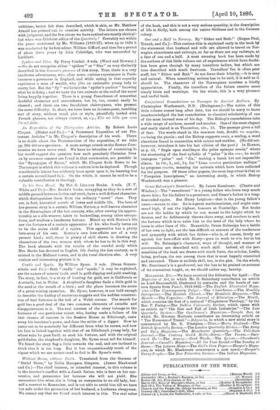English Letters and Letter. Writersof the Eighteenth Century. With Explanatory
Notes. By Howard Williams, M.A. Illustrated with Portraits and Fac-similes. First Series," Swift and Pope." (Bell and Sons.)—This octavo volume of about 550 closely printed pages is, it will be seen, the first of a series. Of Swift as a letter-writer, and incidentally of Pope also, mention was lately made in the Speeator, in a short criticism of the selection from the Dean of St. Patrick's corre- spondence edited by Mr. Lane-Poole. That Swift ranks with the best letter-writers of his century, and that of men distinguished in this way Pope ranks very nearly with the worst, is the opinion we have formed from a familiar acquaintance with the correspondence of the two friends. In the one, WO have spontaneity, freshness, and the chatty familiarity of a man who writes for his own pleasure and the pleasure of the persons he addresses ; in the other, we have the effort to say fine things, to express benevolent sentiments, and to mould every sentence so that it may be fit for publication. It is possible) of course, that, knowing what we do of Pope's artifices about his letters, we may see a trick of the craftsman when he was really uttering the language of the heart. If this be so, the fault is due to the foolish stratagems of the poet, which were suspected long before they were exposed by the late Mr. C. W. Dilke, of whom, by the way, Mr. Williams writes as the father of the present baronet. We do not say there is not rnuch to interest in Pope's letters, for they serve to enlarge our knowledge of the time and of the poet's character ; but regarded as letters, they must rank far below those of Swift, of Lady Mazy W. Montagu, of Horace Walpole, of Cowper, and of Mrs. Carlyle. Mr. Williams appears to have bestowed great labour on this volume ; but we cannot regard the result as altogether satisfactory. An elaborate table of contents occupies more than fifty pages ; this is followed by a long and, we fear we must add, rather tedious bio- graphy of Swift, since it is little more than a recapitulation of facts and comments which Scott and Forster, Mr. Elwin, Mr. Craik, and Mr. Leslie Stephen have made generally familiar. It is possible, indeed, to put new life into well-known statements, and so to carry the reader pleasantly over old ground ; but this is what Mr. Williams fails to do, either in the biography of Swift or in the equally elaborate account of the life and writings of Pope. He writes carefully and con- scientiously, but is wanting in animation, and in that special gift of
criticism, better felt than described, which is akin, as Mr. Matthew Arnold has pointed out, to creative activity. The letters are chosen with judgment, and the few errors we have noticed are mostly clerical ; but when was Gilchrist editor of the Quarterly ? Certainly not within the years mentioned by Mr. Williams (1819-27), when up to 1824 it was conducted by its first editor, William Gifford, and then for a period of about three years by John Coleridge, who was succeeded by Lockhart.



































 Previous page
Previous page